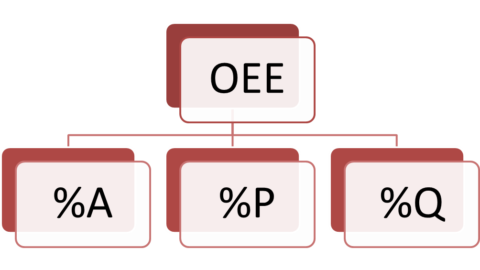
Overall Equipment Effectiveness (OEE) is a basic measure that helps managers evaluate the effectiveness of the overall Equipment Performance Maintenance (TPM) application at the enterprise.
OEE index is calculated based on component indexes including: Availability, Quality Ratio and Performance Ratio. For example:
A plastic molding machine that has been operating for 10 hours at night has 93% efficiency measured from the actual operating time, but the machine has to stop for 1 hour to change shifts. This means unplanned downtime is 10%, which translates to a machine readiness factor of 90%. Next, in those 10 hours, the machine produced 100 products with 95 qualified molds and 5 defects. This number means that the quality factor of the machine is only 95%.
To sum up, the overall device performance index is calculated as follows:
OEE = 90 * 95 * 93/10000 = 79.52%
Through this maybe, if the business improves any of the component indicators in OEE, their performance will also be reflected on OEE. However, the OEE metric does not represent the productivity of your entire system. Many organizations have had trouble using OEE to serve unsuitable goals, typically:
To achieve optimum efficiency when using the OEE metric, organizations should keep an eye on the list of considerations:
Note 1: OEE is best used on a single device, or on synchronous chains
First of all, managers should not use the same OEE calculation method for many different devices, because their quality and performance factor are different. OEE should also not be averaged across the plant as that number does not tell you where your organization is having problems.
OEE is best used for performance measurement and loss analysis on a particular device. When something goes wrong, it provides breakdown of availability, performance, and quality to help you fix the problem.
This also means that OEE on equipment is prone to crashes or bottlenecks (analyze the cause, propose solutions, implement improved solutions) to improve overall performance. In addition, comparing A, P, and Q metrics will indicate specifically whether you are doing the right thing or not. If done right, we will standardize and regulate solutions. And then continue to maintain. Thus, the production process will be like the concept of kaizen, with each day being more and more complete. In this way, OEE is a leading indicator that can point you in the direction of improvement; then it becomes a lag indicator to let you know if you’re doing it right.
Note 2: Don’t set an absolute goal on OEE
Do not choose the company’s target of OEE according to European standards or compare them with any other famous company, because OEE depends on the conditions of each factory.
When it comes to OEE, it doesn’t matter what the OEE value is (17% or 85%), since the amount itself doesn’t make any sense, it depends on what you define as a normal operating state. (or optimal). So what is important when it comes to OEE? The answer is the speed at which the company improves OEE, this is the goal that the organization should aim for.
(To be continued)
Productivity and Quality Office